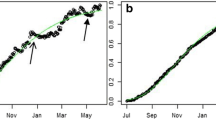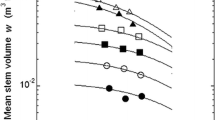Abstract
Interrelationships between self-thinning, biomass density, and plant form were mathematically modeled in relation to stand development in which self-thinning is either not occurring or is occurring. The relationship between biomass density and mean shoot mass is derived as a simple power function at the stage when self-thinning does not occur. When self-thinning occurs, constant biomass density is attained when the 3/2 power law of self-thinning applies and the allometric coefficient is assumed to be 1/3 in the allometry between mean plant height and aboveground mass. The applicability of this mathematical model and the allometric reformulations of the self-thinning exponent were tested using experimental data for dense populations of Chamaecyparis obtusa seedlings during the first 2 years of growth. On the basis of the results of the present model and experimental data, the dependence on competition of the mean height:diameter ratio, mean stem diameter, and leaf biomass density are discussed. As a result, the mean height:diameter ratio was almost asymptotically constant at the latter growth stage in the second-year seedlings, so that the 3/2 power law of self-thinning was held in the present analysis. However, the value of height:diameter ratio will become smaller in older stands, because tree height is considered to be asymptotic with respect to tree age due to hydraulic and other limits. Therefore, the present modeling implies that one of the reasons why the 3/2 power law from a geometric basis has been recently rejected depends on whether or not the height:diamter ratio is constant in older trees.



Similar content being viewed by others
References
Duarte CM, Kalff J (1987) Weight-density relationships in submerged macrophytes. Oecologia 72:612–617. doi:10.1007/BF00378990
Duarte CM, Kalff J (1990) Biomass density and the relationship between submerged macrophyte biomass and plant growth form. Hydrobiology 196:17–23. doi:10.1007/BF00008889
Enquist BJ, Brown JH, West GB (1998) Allometric scaling of plant energetics and population density. Nature 395:163–165. doi:10.1038/25977
Harper JL (1977) Population biology of plants. Academic Press, London
Hutchings M (1983) Ecology’s law in search of a theory. New Sci 16:765–767
Kikuzawa K (1999) Theoretical relationships between mean plant size, size distribution and self-thinning under one-sided competition. Ann Bot (Lond) 83:11–18. doi:10.1006/anbo.1998.0782
Kira T, Shidei T (1967) Primary production and turnover of organic matter in different forest ecosystems of the western Pacific. Jpn J Ecol 17:70–87
Lillie RA, Budd J, Rasmussen PW (1997) Spatial and temporal variability in biomass density of Myriophyllum spicatum L. in a northern temperate lake. Hydrobiology 347:69–74. doi:10.1023/A:1003059000277
Lonsdale WM (1990) The self-thinning rule: dead or alive? Ecology 71:1373–1388. doi:10.2307/1938275
Lonsdale WM, Watkinson AR (1983) Plant geometry and self-thinning. J Ecol 71:285–297. doi:10.2307/2259977
Mohler CL, Marks PL, Sprugel DG (1978) Stand structure and allometry of trees during self-thinning of pure stands. J Ecol 66:599–614. doi:10.2307/2259153
Newton PF, Smith VG (1990) Reformulated self-thinning exponents as applied to black spruce. Can J Res 20:887–893. doi:10.1139/x90-119
Norberg RA (1988) Theory of growth geometry of plants and self-thinning of plant populations: geometric similarity, elastic similarity, and different growth models of plant parts. Am Nat 131:220–256. doi:10.1086/284787
Ogawa K (2001) Time trajectories of mass and density in a Chamaecyparis obtusa seedling population. For Ecol Manage 142:291–296
Ogawa K (2003) Size dependence of leaf area and the mass of component organs during a course of self-thinning in a hinoki (Chamaecyparis obtusa) seedling population. Ecol Res 18:611–618. doi:10.1046/j.1440-1703.2003.00582.x
Ogawa K (2005a) Relationships between mean shoot and root masses and density in an overcrowded population of hinoki (Chamaecyparis obtusa (Sieb. et Zucc.) Endl.) seedlings. For Ecol Manage 213:391–398
Ogawa K (2005b) Time-trajectory of mean phytomass and density during a course of self-thinning in a sugi (Cryptomeria japonica D.Don) plantation. For Ecol Manage 214:104–110
Ogawa K (2008) The leaf mass/number trade-off of Kleiman and Aarssen implies constancy of leaf biomass, its density and carbon uptake in forest stands: scaling up from shoot to stand level. J Ecol 96:188–191
Ogawa K, Hagihara A, Hozumi K (1989) Periodic shoot and root growth in first-year seedlings of hinoki (Chamaecyparis obtusa). J Jpn For Soc 71:196–199
Ogawa K, Hagihara A, Hozumi K (1990) Seasonal changes in specific leaf area of hinoki (Chamaecyparis obtusa) seedlings during the first two-years. J Jpn For Soc 72:342–344
Osawa A, Allen RB (1993) Allometric theory explains self-thinning relationships of mountain beech and red pine. Ecology 74:1020–1032. doi:10.2307/1940472
Perry DA (1994) Forest ecosystems. The Johns Hopkins University Press, Baltimore
Ryan MG, Yoder BJ (1997) Hydraulic limits to tree height and tree growth. Bioscience 47:235–242. doi:10.2307/1313077
Scrosati R (2000) The interspecific biomass-density relationship for terrestrial plant: where do clonal red seaweeds stand and why? Ecol Lett 3:191–197. doi:10.1046/j.1461-0248.2000.00133.x
Silvertown JW, Charlesworth D (2001) Introduction to plant population biology, 4th ed. edn. Blackwell, Oxford
Silvertown JW, Doust JL (1993) Introduction to plant population biology. Blackwell, Oxford
Verkerk PJ (2005) The role of crown packing on the ability of trees to compete for light in a temperate mixed natural regeneration. Master’s thesis, Wageningen University, The Netherlands
Weiner J, Thomas SC (1992) Competition and allometry in three species of annual plants. Ecology 73:648–656. doi:10.2307/1940771
Weiner J, Berntson GM, Thomas SC (1990) Competition and growth form in a woodland annual. J Ecol 78:459–469. doi:10.2307/2261124
Weller DE (1987a) A reevaluation of the -3/2 power rule of plant self-thinning. Ecol Monogr 57:23–43. doi:10.2307/1942637
Weller DE (1987b) Self-thinning exponent correlated with allometric measures of plant geometry. Ecology 68:813–821. doi:10.2307/1938352
Weller DE (1989) The interspecific size-density relationship among crowded plant stands and its implications for the -3/2 power rule of self-thinning. Am Nat 133:20–41. doi:10.1086/284899
West GB, Brown JH, Enquist BJ (1997) A general model for the origin of allometric scaling laws in biology. Science 276:122–126. doi:10.1126/science.276.5309.122
Westoby M (1984) The self-thinning rule. Adv Ecol Res 14:167–225. doi:10.1016/S0065-2504(08)60171-3
White J (1980) Demographic factors in populations of plants. In: Solbrig OT (ed) Demography and evolution in plant populations. Blackwell, Oxford, pp 21–48
White J (1981) The allometric interpretation of the self-thinning rule. J Theor Biol 89:475–500. doi:10.1016/0022-5193(81)90363-5
White J, Harper JL (1970) Correlated changes in plant size and number in plant populations. J Ecol 58:467–485. doi:10.2307/2258284
Xue L, Ogawa K, Hagihara A, Liang S, Bai J (1999) Self-thinning exponents based on the allometric model in Chinese pine (Pinus tabulaeformis Carr.) and Prince Repprecht’s larch (Larix principis-rupprechtii Mayr) stands. For Ecol Manage 117:87–93
Yoda K, Kira T, Ogawa H, Hozumi K (1963) Self-thinning in overcrowded pure stands under cultivated and natural conditions. (Intraspecific competition among higher plants XI). J Biol Osaka City Univ 14:107–129
Zeide B (1987) Analysis of the 3/2 power law of self-thinning. For Sci 32:517–537
Acknowledgments
Special thanks are offered to Donald Weller for helpful discussions regarding the results; to the staff of the Nagoya Regional Forest Office, Forest Agency, and the Midorigaoka Nursery of the Gifu District Forest Office for access to their facilities; and to my colleagues for their help with fieldwork. This study was supported in part by a Grant-in-Aid for Scientific Research (No. 19580170) from the Ministry of Education, Science, Sport and Culture, Japan, and a grant from the Sumitomo Foundation (No. 073010).
Author information
Authors and Affiliations
Corresponding author
Additional information
Communicated by K. Puettmann.
Rights and permissions
About this article
Cite this article
Ogawa, K. Theoretical analysis of the interrelationships between self-thinning, biomass density, and plant form in dense populations of hinoki cypress (Chamaecyparis obtusa) seedlings. Eur J Forest Res 128, 447–453 (2009). https://doi.org/10.1007/s10342-009-0292-4
Received:
Revised:
Accepted:
Published:
Issue Date:
DOI: https://doi.org/10.1007/s10342-009-0292-4




